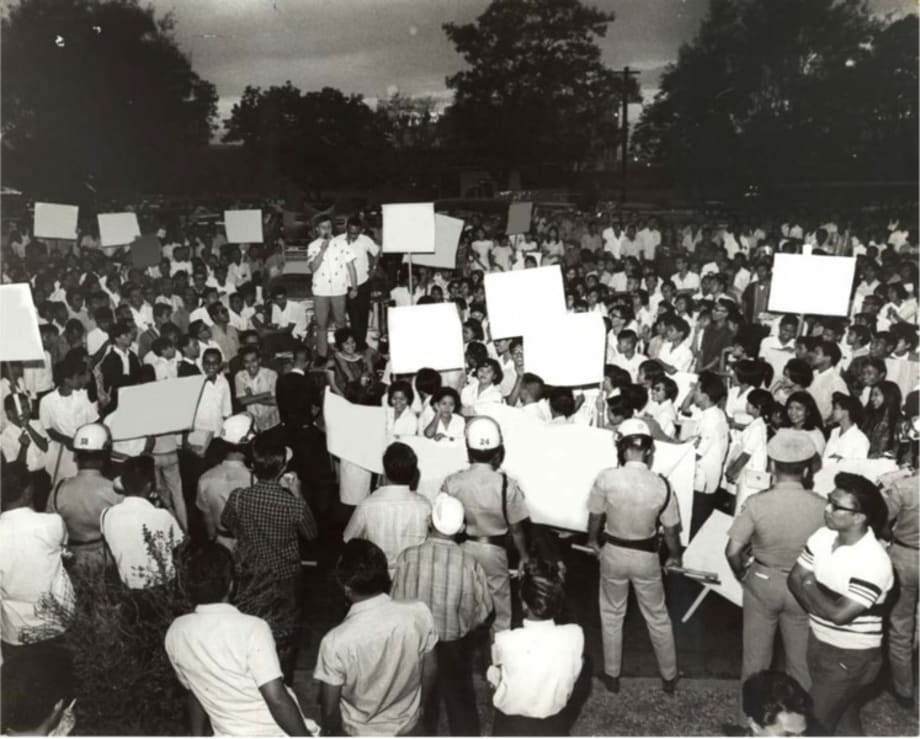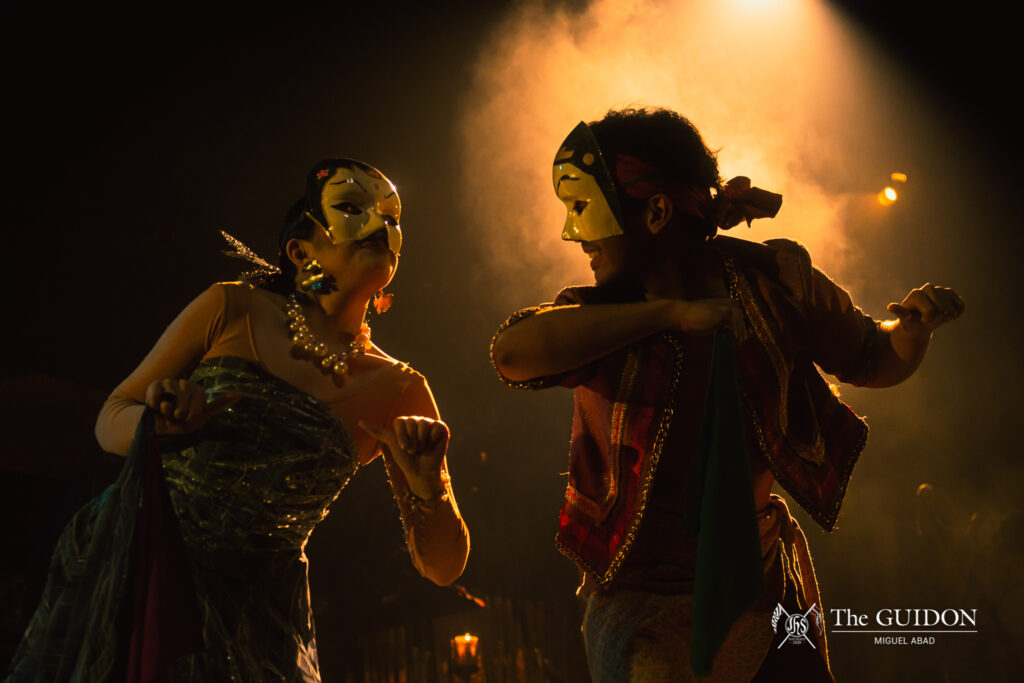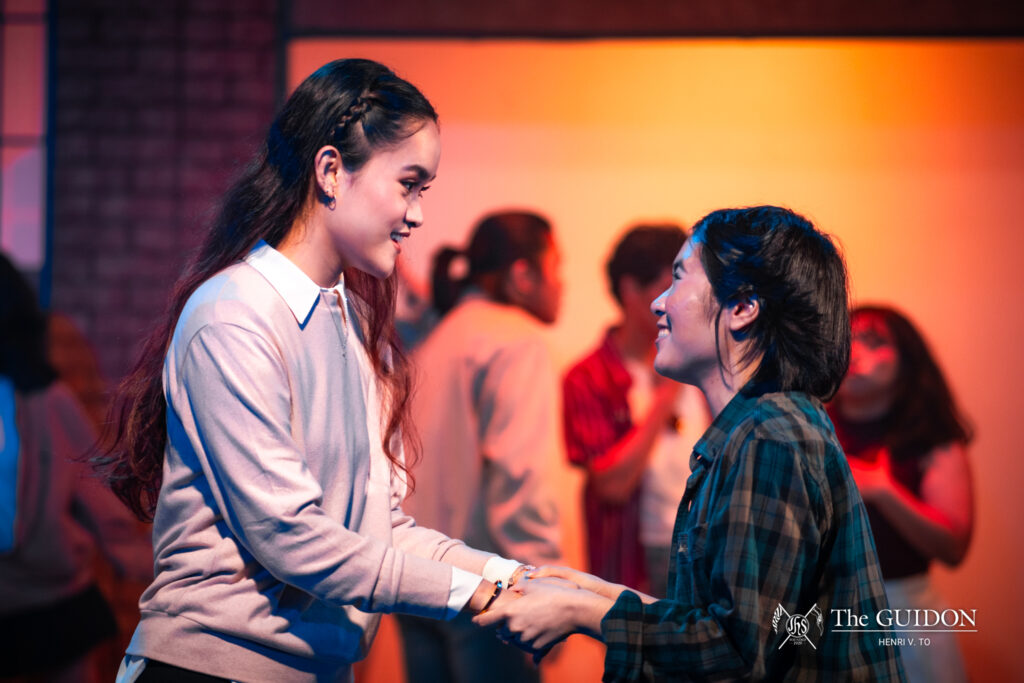49 years later, Martial Law’s far-reaching consequences are still felt in the economic, environmental, and social arenas. As the threat of historical revisionism perseveres, the variegated works of Filipino artists produced out of their continual engagement and response to the issues of the regime become vital.
Protest art is not merely relegated to the time of that which it opposes; it continues until the echo is felt. As artists carry on producing such responses through their practices, the representative body of artworks must also be updated.
In this listicle, Vantage lines up five works of significant Martial Law-related art crafted by women through the years. Their art reveals intersectional issues between the regime and women while also contributing to a richer understanding of Philippine art.
Oppose State Terrorism (1985) by Anna Fer
Image: Ateneo Art Gallery
Oppose State Terrorism (1985) is a response to Marcos’ demand for a snap election, depicting the state’s acts of terrorism towards civilians. The poster, which was created as promotional material for a series of talks about Martial Law victims, emphasizes the violence that arises when justice is absent. The image is illustrated in only black and red—colors which give the artwork an aggressive tone. Additionally, the acts of police brutality shown are seemingly engulfed in flames. The text at the bottom of the work pays tribute to the victims of Ferdinand Marcos’ administration, saying “Alay sa laya ng bayan. Gabi ng pagpupugay sa mga biktima ng karahasan. (Offering for the liberation of the people. Evening of tribute to the victims of violence).” As long as police brutality and abuse of power prevail, Fer’s call to oppose state terrorism remains relevant.
Girls in Ermita (1983) by Pacita Abad
Image: MAP Magazine
Girls in Ermita (1983) is part of Pacita Abad’s “Immigrant Experience” series, portraying her encounters with people all over the world. Although it is not directly about Martial Law, the work features the women of Manila’s red light district at that time. Abad’s piece encapsulates the oppressive nature of sex work, with most migrant sex workers being forced by their circumstances to pursue it. Nonetheless, she depicts these sex workers as active rather than passive subjects. The women still pose proudly as if to assert themselves against sexual exploitation and powerlessness. Abad’s work is ironically empowering, especially given the limited agency and abuse women endured during Martial Law.
Erased Slogans (2016) by Kiri Dalena
Image: Art Basel
Kiri Dalena’s series Erased Slogans (2016) consists of altered newspaper images from the protests prior to the Martial Law declaration in 1972. By erasing the words on protesters’ signs, she emphasizes the role that artists play in historical amnesia. Dalena notes that the erasure has multiple meanings ranging from forgetting the events that transpired to silencing the voices of these victims. With perseveringly present acts of historical revisionism such as Marcos’ burial in Libingan ng mga Bayani, Erased Slogans (2016) is a reminder to fervently remember what these protestors fought for.
Ang Asawa ay DH (1995) by Imelda Cajipe-Endaya
Image: Asian Art Histories
Known by the titles “Ang Asawa ay DH,” “The Wife is a DH,” or “My Wife is a DH,” Imelda Cajipe-Endaya’s 1995 mannequin-like installation explores the intersections between women and labor migration. In all its names, it appears that the DH is never her own person. This piece reflects the economic standstill that the Marcos administration had left the country in, causing an increase in workers seeking opportunities abroad.
In 1995—the year this piece was made—62,107 female domestic helpers were deployed overseas in contrast to the 1,356 males. Visualizing these numbers, Cajipe-Endaya used objects to recall the stereotypical possessions of a DH working abroad. On one hand, she emphasizes the idea of the DH being treated as an object. On the other, the firm stance of the mannequin appears to show the opposite—a refusal to be seen as expendable. In all cases, this silent violence against migrant domestic helpers was exacerbated at the hands of the Marcos regime and its legacy.
Homage to Ambrogio Lorenzetti (1987) by Ofelia Gelvezon-Tequi
Image: OGT NM Catalog
In Homage to Ambrogio Lorenzetti (1987), Gelvezon-Tequi references the allegory of justice in Lorenzetti’s Palazzo Pubblico fresco. According to the print’s catalog, the five soldiers on the foreground are those accused of assassinating Ninoy Aquino, while the central figure who tips the scales is Maria Clara. Although its reference to Martial Law is clear, the role of Maria Clara also brings out feminist themes. By turning her into a central figure who “tips the scales,” Gelvezon-Tequi acknowledges the role of women in nation building. From the traces of the EDSA Revolution to the dawn of the new 1987 Constitution, Gelvezon-Tequis sends out a reminder that justice is not complete if it does not include women in its course. The Latin phrase above Maria Clara even advises to “Love justice you who rule the world.”
As cultural critic Walter Benjamin has stated, “Every image embodies a way of seeing,” and this allows us to empathize with their creators’ stories.
These works become more vital than ever as female artists continue to uphold our nation’s collective memory. The issues they confronted, such as state violence and the threat of historical revisionism, still persist today. In their quest to preserve the truth, these artists remind us to preach it with conviction and remain vigilant when faced with injustice.






